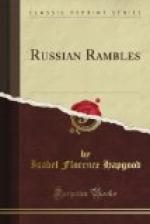Our comfortable hotel possessed not a single characteristic feature, except a line on the printed placard of regulations posted in each room. The line said, “The price of this room is four rubles [or whatever it was] a day, except in Contract Time.” “Contract Time,” I found, meant the Annual Fair, in February, when the normal population of about one hundred and sixty-six thousand is swelled by “arrivers”—as travelers are commonly designated on the signboards of the lower-class hotels— from all the country round about. When, prompted by this remarkable warning, I inquired the prices during the fair, the clerk replied sweetly,—no other word will do justice to his manner,—“All we can get!” Such frankness is what the French call “brutal.”
The principal street of the town, the Krestchatik, formerly the bed of a stream, in front of our windows, was in the throes of sewer-building. More civilization! Sewage from the higher land had lodged there in temporary pools. The weather was very hot. The fine large yellow bricks, furnished by the local clay-beds, of which the buildings and sidewalks were made, were dazzling with heat. It is only when one leaves the low-lying new town, and ascends the hills, on which the old dwellers wisely built, or reaches the suburbs, that one begins thoroughly to comprehend the enthusiastic praises of many Russians who regard Kieff as the most beautiful town in the empire.
The glare of the yellow brick melts softly into the verdure of the residence quarter, and is tempered into inoffensiveness in the Old Town by the admixture of older and plainer structures, which refresh the eye. But the chief charm, unfailing, inexhaustible as the sight of the ocean, is the view from the cliffs. Beyond the silver sweep of the river at their feet, animated with steamers and small boats, stretches the illimitable steppe, where the purple and emerald shadows of the sea depths and shallows are enriched with hues of golden or velvet brown and misty blue. The steppe is no longer an unbroken expanse of waving plume-grass and flowers, wherein riders and horses are lost to sight as, in Gogol’s celebrated tale, were Taras Bulba and his sons, fresh from the famous Academy of Kieff, which lies at our feet, below the cliffs. Increasing population has converted this virgin soil into vast grainfields, less picturesque near at hand than the wild growth, but still deserving, from afar, of Gogol’s enraptured apostrophe: “Devil take you, steppe, how beautiful you are!”
Naturally, our first pilgrimage was to the famous Kievo-Petcherskaya Lavra, that is, the First-Class Monastery of the Kieff Catacombs, the chief monastic institution and goal of pilgrims in all the country, of which we had caught a glimpse from the opposite shore of the river, as we approached the town. Buildings have not extended so densely in this direction but that a semblance of ascetic retirement is still preserved. Between the monastery and the city




